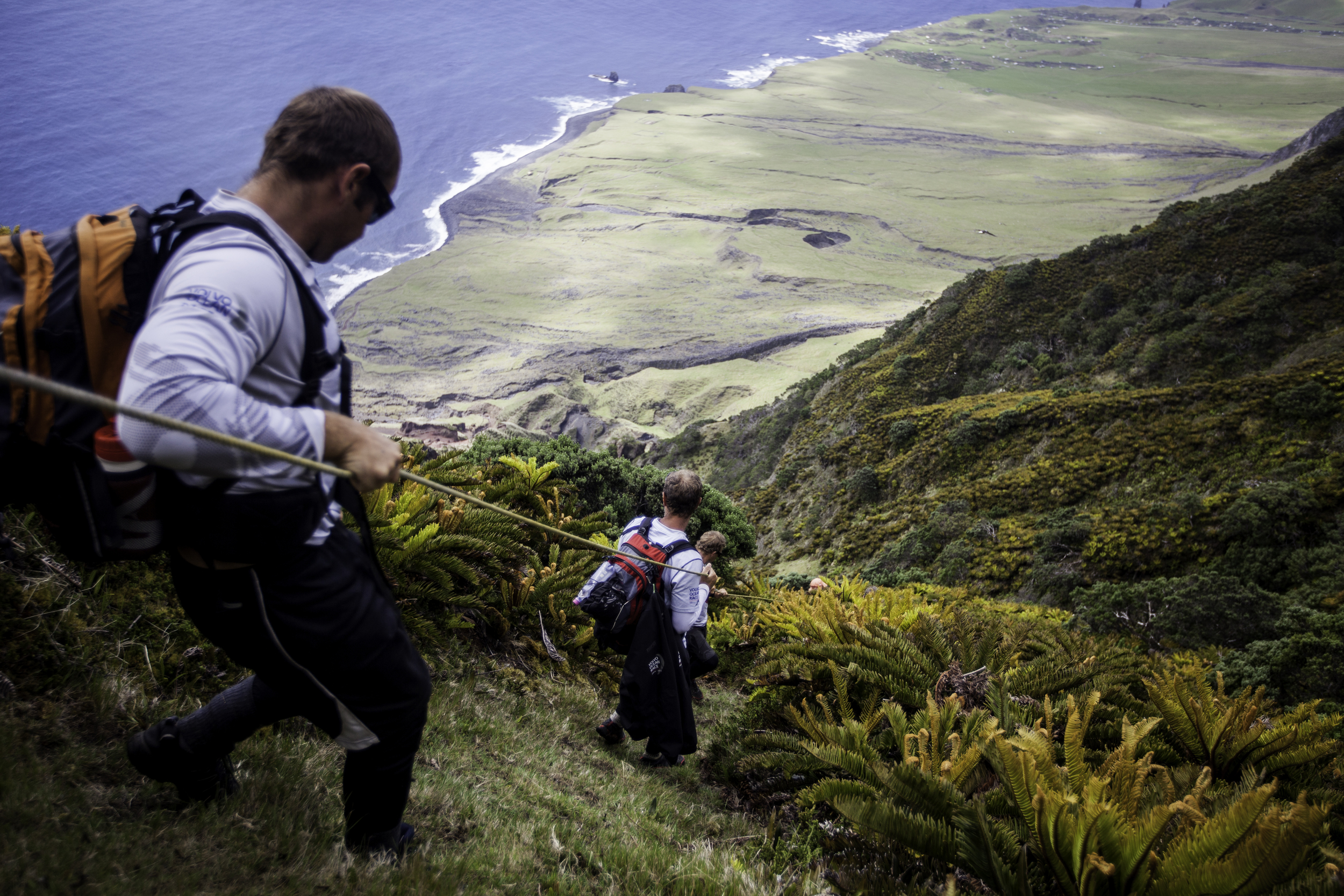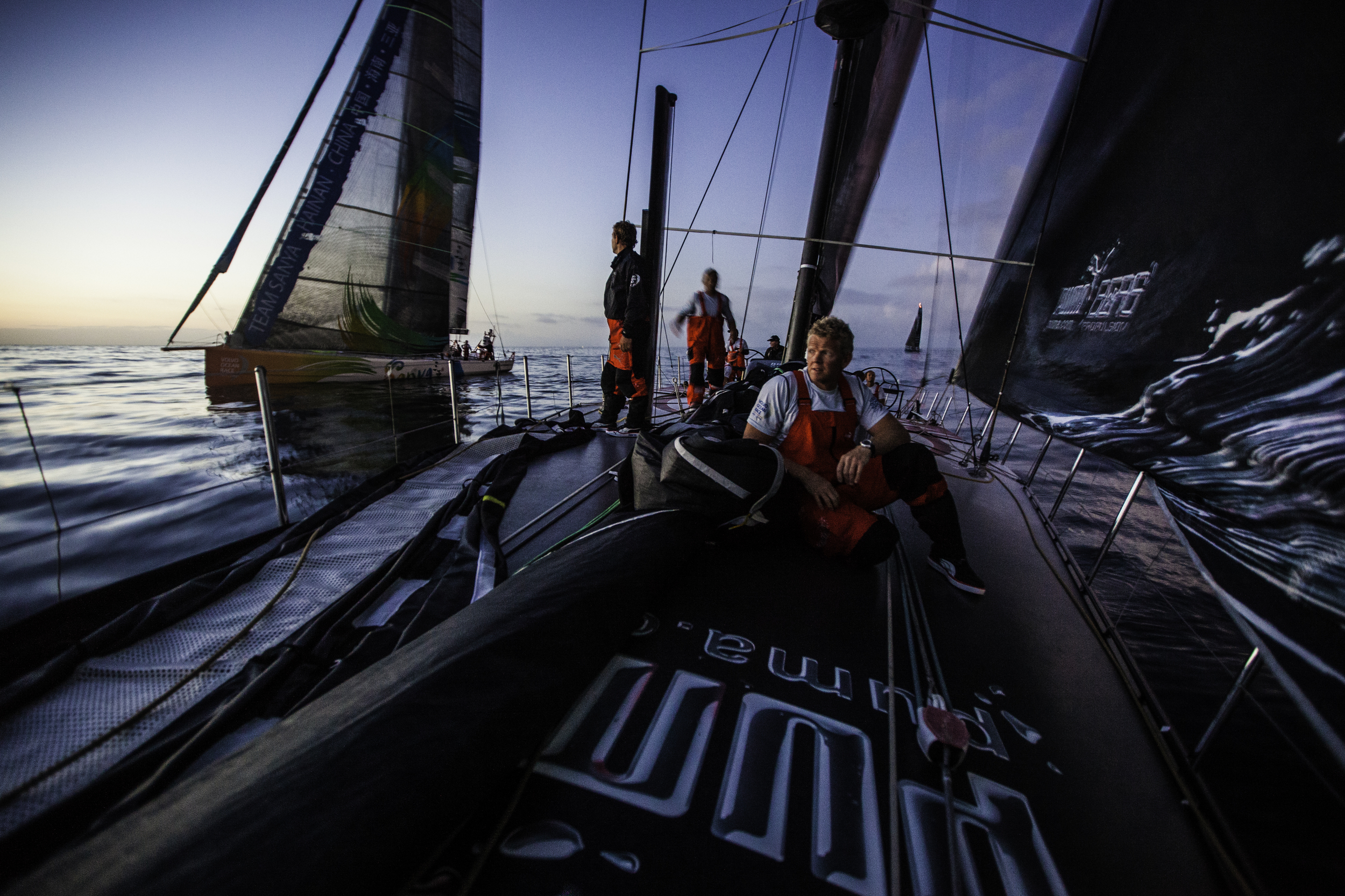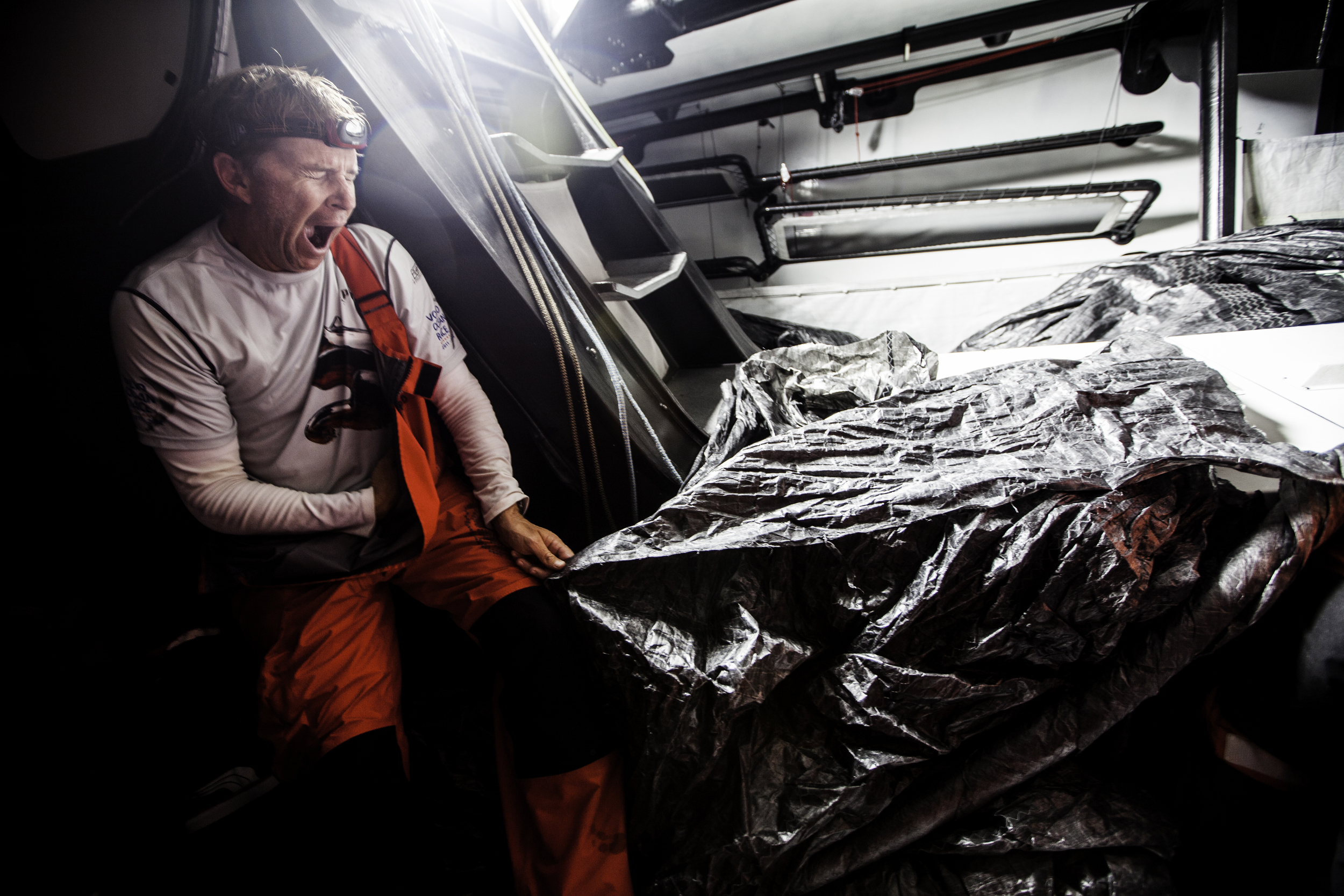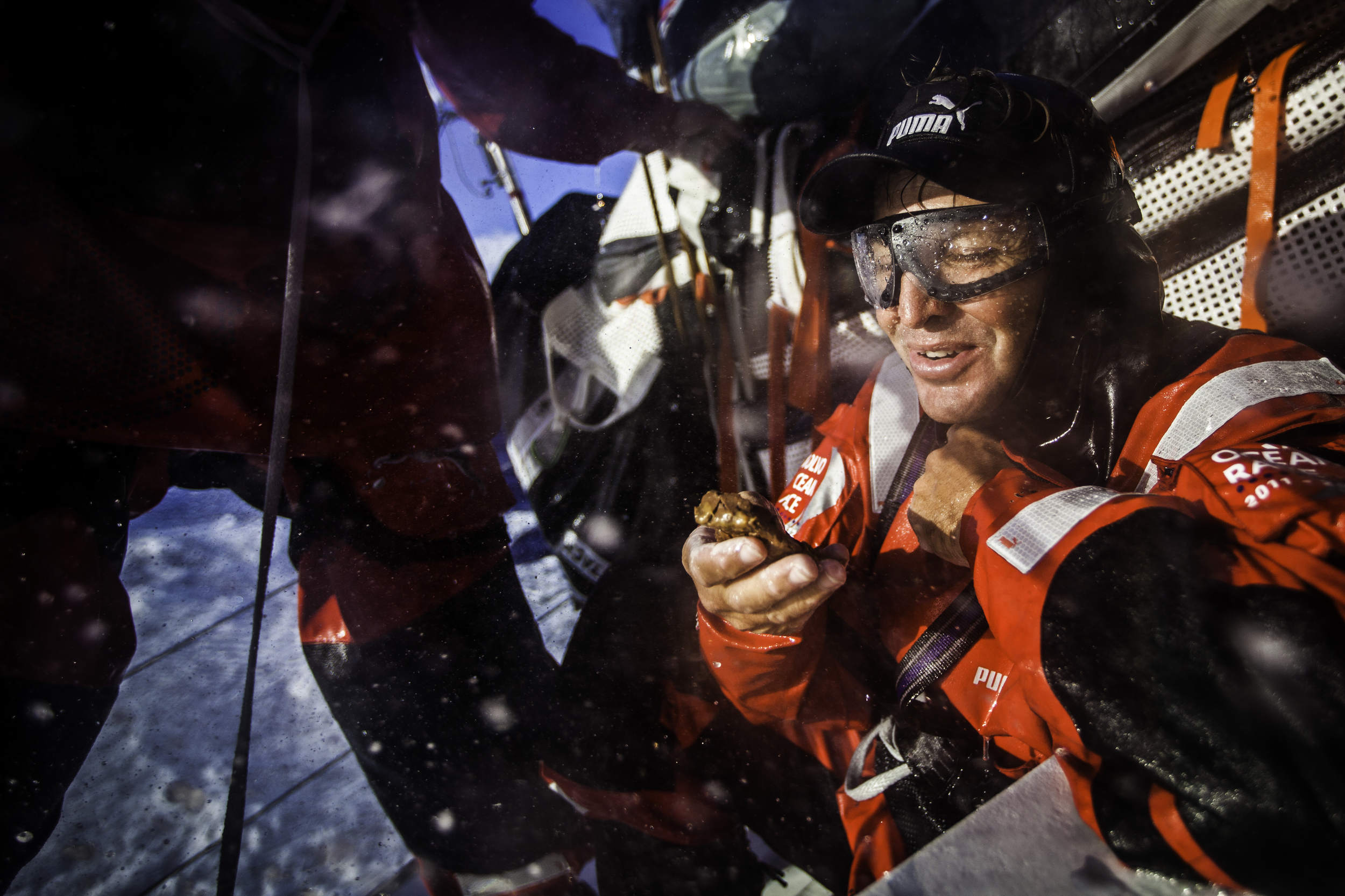2011-2012 VOLVO OCEAN RACE WITH PUMA OCEAN RACING
The Volvo Ocean Race, one of sailing's marquee events, is a ten-month 39,000-mile sprint around the world divided into nine legs. New to the onboard requirements was a Media Crewmember whose main responsibilities included daily videos, pictures, and written stories transmitted from the middle of the world’s oceans. In addition to being the single point of content creation, you have to exist and survive as a working part of a professional sports team racing across oceans for months at a time.
DAILY BOATFEEDS
DAILY BLOG excerpts
“There wasn’t much wind so I sat on the sail stack, near Ken. After a few minutes of silence, he turns and says “this is the worst day on the water I’ve had in a really long time.” I don’t think he was necessarily talking to me, but I heard it for what it was—utter frustration. A short time later I asked if there was anything I could get him, “three knots and a massive lefty.” I didn’t bother responding and it took another few minutes to realize these are the times I need to be filming, so I got my camera. When I came back I went straight to the one guy who had the longest day of them all: Tom. As navigator he more than anyone had been waiting for those three knots, from the left. Now recording, I asked how our lead had evaporated over the course of the day and rather than despair I got an answer full of detail, enthusiasm, and humor. He ends with “there’s a long way to go and the sun will come up tomorrow. Could be worse, could be better. But it could be worse too.” It’s a great sign, that one really bad day can’t take him down so early in this race. Everyone is motivated to regain the lost miles and I even heard Ken laughing before the day was done." November 19, 2011. Leg 1, Day 14
“It’s taken a night’s sleep and a shockingly awkward awakening this morning to realize what happened has, in fact, happened. We are dismasted in the middle of the South Atlantic, 2,100 miles from Cape Town, and we’re limping to a small island called Tristan da Cunha about 700 miles away. I remember the moment precisely: I’d just come down from a few hours on deck to grab lunch - the last of it in the pot. I sat down next to Rome on the high side floor. A few minutes later came a noise like I have never, ever, heard before. Kind of like a tree falling in your back yard, but twice as loud and twice as quick, directly overhead. Without the pressure in the sails to push against the canted keel, we rolled hard to windward and I found myself on my back, feet in the air, food on my chest. With the thick black mainsail now covering the only light source in the open companionway, it was immediately dark inside the boat. Ryan yells “RIG DOWN!” through the hatch and I recall a flurry of thoughts too quick to comprehend, but the gist is this: how bad?" November 22, 2011. Leg 1, Day 17
“Yesterday a group of us decided that waking up at 6 AM and climbing a 6,800-foot volcano was a good idea. Not only did we do it in sailing shoes, we went up and down in nine hours. Our guides Simon and Matthew claimed that to be a record for visitors. After lunch in the crater—snow still clinging to its walls—we summited and then took a rarely seen descent down the backside. We passed groups of nesting Yellow Nosed Albatrosses, sheer cliffs, sheep, bogs, volcanic rock, and red sand dunes on the way to a waiting Land Rover at the bottom. The trek back to town was a quiet one and nobody paid much attention to the whales breaching offshore; we were already fantasizing about cold beer in the fridge." November 30, 2011. Leg 1, Day 25
“A lot of people wonder what can you do to stay dry at 24 knots. The easy answer is nothing. You live wet and deal with it. No item of clothing can withstand the torrential torrent of water over the deck and there’s zero chance of drying anything in the heat and humidity. What’s wet stays wet. All you can do is figure out how much spare clothing you have, how much time you have left onboard, and schedule your wardrobe rationing accordingly. But to be honest it’s pointless to worry about these things—this is not a race of comforts." February 29, 2012. Leg 4, Day 10
“We continue to careen around the Pacific like an angry New York City taxi. One minute we’re skipping down the face of a wave only just in control, the next we’re slamming into a wall of water, bringing the boat to a head-jerking and body throwing stop, before repeating the cycle again. It’s fun but exhausting, and catching up on rest hasn’t been easy. Sleeping on these boats can be a bit of a mystery. Sometimes you can, sometimes you can’t. A lot of it depends on just how tired you are. When living conditions are at their absolute worst and you’re so run down, you can sleep anywhere anytime. In those instances someone can be so “out” they sleep through anything. It takes an abusive shaking to wake someone like that up for their watch. But the other 90% of the time, when you’re just really tired, sleeping can be hard. The boat is loud and it’s like trying to sleep inside a drum. The boat is unpredictable. Your body gets acclimated to one rythm and then it’s completely upended when you're thrown in the opposite direction. The air is hot or cold, never dry. Everything is wet—your pillow, your sleeping bag, your hair. It smells like you'd imagine it would. People are moving and talking everywhere. Fortunately, when the sailing is as fun as it is now everyone has something to get up for so we happily roll out of our bunks, put on our already wet wet-weather gear, head on deck and continue to chase down the French, 80 some-odd miles off the bow." March 1, 2012. Leg 4, Day 11
“Mental strength carries twice the value of physical strength in this foreign world, and one thing we learned the hard way leaving Auckland was that if we’re not mentally prepared for what is coming, our bodies are useless. We’re keen to avoid the same mistake this time, so we’ve been taking care of the little things over the last few days in order to enjoy these final hours of relative peace. Neck and wrist seals on our survival suits have been trimmed, valuables are stowed, and the essentials are within close reach. Warm clothes and dry replacements are organized and waiting in the wings. Hatches are closed, sealed, and re-sealed, headlamp batteries are replaced, and water tanks filled. The rig has been checked for signs of vulnerability, the wave deflector has been installed, the rudder quadrants tightened, and future sail changes discussed. And discussed again. Once things start to get loud the obvious priorities are to keep everyone safe, hold the boat together, minimize mistakes, and go as fast as possible towards the first ice gate." March 22, 2012. Leg 5, Day 4
“One second we’ll be doing thirty knots through the water, the next, fifteen, and the transition period between those two speeds is almost instantaneous. Guys are literally flying out of the bottom of their bunks and if you’re not holding onto something at all times you could find yourself doing the superman slide across the deck or through the interior. Not fun, or safe. Just doing anything in these conditions takes three times longer than normal, take typing for example. One letter at a time because your head and the keyboard are in a constant state of disagreement, vision and coordination never quite aligning well enough for any degree of efficiency. Or cooking. Trying to fill the kettle with water from the tap while it literally pings off the sides of the sink is almost easier than trying to pour the boiling water in the pot an hour later. I’d say it’s 50/50, half in, half out. So you have to do it twice, maybe three times. It’s cold, it’s wet, living is tough, surviving is rough. But we’re having fun, going fast, and looking forward to another week of this before Cape Horn." March 23, 2012. Leg 5, Day 5
“Perhaps the biggest adjustment of being in the proper Southern Ocean is in the way we handle clothing and staying dry. It’s absolutely vital to a healthy existence. I was warned in Auckland, “you get wet, you die,” because the air is too damp to dry anything and the temperatures are too cold to risk being wet. Self-sustainability starts with making sure your sleeping bags, socks, pants, shirts, and fleeces survive—they’re all essential and our personal bags aren’t big enough to carry spares. By now most of us have opted for survival suits, which keep water out, but they don’t breathe well and you end up sweating a lot, at least as much as you might suffer from water ingestion. There’s no right or wrong solution and to each his own. I have a unique set of clothes for sleeping. Warm, dry clothes that never leave my bunk. Wet feet are inevitable from walking around the boat so I have a pair of waterproof socks that I also wear when in my boots. The socks under those, they get damp from sweat so I have two or three pairs I rotate through while putting the soggy ones in my sleeping bag overnight, a trick that helps to suck out some of the moisture. But it leaves a repulsive smell that’s a bit like popcorn." March 24, 2012. Leg 5, Day 6
“Cape Horn looked like any other rugged seaside outcropping on the horizon, jagged and torn from years of constant battering much like the kind we just spent twelve days enduring. As we approached though, sailing past snow-capped mountains and a brilliant red sunrise, I began to realize that the Horn’s spectacle is not in its beauty but its significance. This is Cape Horn, the southernmost tip of South America, and the southernmost point of land on Earth. It is cold, dark, and raw, and the living is tough. And as impressive as the rock stood, it stands for so much more: it represents total challenge and rewards those who accept it responsibly. And looking at that ominous island today, I realized that I pushed myself and my limits well beyond a point I ever thought possible. Odds are, most everyone who first journeys around that point feels a similar prick of pride. So yes, today we sailed by a big black rock with green stuff growing on the side. But today we also accomplished something great. That Southern Ocean leg was one for the ages, and we made it here together. We did it the right way, the safe way, and we had fun doing it. Handshakes, smiles, cigars, and a swig of rum confirmed that there was something to celebrate—something very different for everyone—and then we were on our way again, eyes aimed north towards Brazil." March 31, 2012. Leg 5, Day 13
“Living at sea can be a lot of fun and the remoteness that it demands can be rewarding, but the days after leaving shore are often filled with frustrating withdrawal from connectivity. Take, for example, hockey. The New York Rangers and the Boston Bruins both faced playoff extermination in their respective series, but both just won decisive game 6's to stay alive and force do-or-die game 7’s. To be out here, unable to watch, listen, or even check scores is agonizing, though it’s something we all eventually acclimatize to. Blackberry’s, iPhones, and the internet are switched off until we get to land. Our only link to the outside world once we leave the dock is the communications computer in the nav station, and its outreach is limited to email. Even email is screened and monitored by a team of Duty Officer’s at race HQ to make sure no outside assistance or sensitive information makes its way on or off the boats. So we’re forced to live through a small number of words for weeks at a time, and in the case of sports updates—we put our considerable faith in a few good patrons who don’t realize how enviable their position in front of a TV really is. But that is Mar Mostro life, and slowly but surely we again come to appreciate “unplugging,” and our focus turns instead to sailing, 3-hour scheds, weather, and sleep." April 23, 2012. Leg 6, Day 2
“One major component of sailing around the world that never shows up on any scoresheet or progress report is team camaraderie. We spend the better part of a year and a half with the same 10 guys, day in and day out, but unfortunately the tune of this race leaves little time or opportunity to relax. We exhaust most of our days running by each other on our separate paths around the boat. Routines are routines for a reason, and rarely do we have the conditions to break out of them. But this leg has been different. For the first time I can remember this race, it’s pleasant enough to be on deck at all hours of the day. Day, night, dusk, dawn, it doesn’t matter. Life is dry, warm, and the seas are flat. Guys are spending their off watches talking on the rail, shooting the poop, so to speak. Resting is easy, sleep is plentiful, and for the most part everyone seems eager to be on deck when they can be. We’re talking so much that maybe it’s a distraction, a legitimate detriment to our performance. The groan of eased sheets and clicking of spinning winches is often lost in the sound of laughter. Inside jokes are being hammered more than ever and the mood seems unusually casual. It feels like we’re getting to know each other all over again, and it has made what otherwise could be considered a “boring” sail very enjoyable." April 26, 2012. Leg 6, Day 5
“I wonder about the countless mariners we randomly intersect out here, the lives we intermittently traverse in the middle of the worlds ocean. What do they do when they return to land? Are they new PUMA Ocean Racing fans? Are they reading this update, followers of our plight like the sailors of the ZIM MONACO who helped us in the South Atlantic? Did they Instagram a photo of us from their smartphone? Or are we just an intense oddity during an otherwise typical workday for some seafarer that knows nothing of Volvo cars, PUMA clothing, carbon fibre, or the World Wide Web? There was the ship of long liners off Sri Lanka, forcing us into a hard bear away and a race-mark like rounding, mere feet between us; we were close enough to taste the stench from their hold. There were the unlit dinghies in the Malacca Straits, clueless as to the danger a night in our path could present. There was the teeming port of Singapore and an evening spent dodging and weaving hundreds (maybe thousands) of anchored 300-meter ships. There were the fishing boats off Japan and the fishing boats off the Solomons. There was the fleet of halogen-lit squidders near Chile and the busy trans-South Atlantic shipping lanes. As we sail north through the Caribbean and finally arrive to very modern civilization in Florida, it’s hard not feeling a tinge of admiration for the simpler sailors we meet out here. Our brief exposure to their world on the sea is as much a surprise to us as we must be to them." April 29, 2012. Leg 6, Day 8
“Typical watch routines have you getting up out of your bunk, dressing for the conditions, and then going to the nav station for a pre-watch race update before going up for your four hour stint. How have the last four hours been, who’s doing what, who’s going where, what have we been steering, etc, etc. It's your time to get up to speed. Yesterday’s fleet reshuffling completely changed that onboard vibe though. Each new watch change brought more “what are they doings” and “did you see this, did you see thats.” This is exciting for us--to be back in this race--and every three hour sched brings more fascination with the prospect of seeing the two race leaders dragged off into a different area code, a place we didn’t see any benefit in going. It was a lifting feeling, and we're feeding off of it for sure." May 25, 2012. Leg 7, Day 5
“It’s always fun waking up to the sound of water rushing by your head at 20 knots. Lying there in the bunk the noises and feelings just ooooze speed, even if you can't see it. Imagine climbing into a Formula 1 car, blindfolded. Would not seeing lessen the sensation on the body? Probably not much. Just like 5500 RPMs would put your head against the back of the seat and your stomach in your throat, walking around inside this boat right now you better be holding on because the acceleration when we take off down a wave is real, and so is the “braking” when we crash at the bottom. And man it is LOUD. The water rushing underneath and around you, and the sudden swoosh of a wave along the deck over your head--there is a palpable sense of extreme velocity that you can just feel." May 28, 2012. Leg 7, Day 8
“The North Atlantic feels a bit like the Southern Ocean on days like these. I went back to jamming my feet in the bunk/hull seam as I slept last night to keep from sliding off the end, a move I haven’t pulled since latitude 58 South. And you’d think after 20-plus days of suffering through this down there we’d be pretty tired of it, but there’s still the smallest bit of satisfaction to be gained from walking that fine line of control. It sounds ridiculous to suggest but on some level there’s nothing extraordinary about these conditions or the way we handle them anymore. I remember seeing 28 knots of boatspeed for the very first time on leg 1, and that no longer stands out. 28 feels average now, as is 30 knots of wind. But what’s not average, what still surprises and impresses me, is the way everyone has the motivation to get up on day 100-and-whatever and push things to the limit, over and over again. Reef when it’s needed, but as soon as it’s not—shake that puppy out and stomp the pedal right to the floor." June 14, 2012. Leg 8, Day 4












































































